Grow citrus
No wonder citrus trees are so popular. With their cheerful winter colour, delicious health-giving fruit, glossy evergreen leaves, fragrant blossoms, a lovely shape and not too large - what more could we want from a tree?
Mandarins
Satsuma mandarins such as ‘Miho’, ‘Miyagawa’, and ‘Silverhill’ have a loose easy peel skin. Great for family gardens, they are small trees with an appealing spreading shape. They are also among the most cold tolerant citrus and make a lovely courtyard tree with their intensely fragrant summer flowers. The various Satsuma cultivars offer a range of harvest times, so if you have the space it’s worth planting more than one. The ‘Clementine’ mandarin is a much smaller tree with very compact growth, ideal for pots and formal gardens. It has spherical fruit and bright green leaves.
Oranges
Oranges are more cold tolerant than lemons, but they need plenty of sunshine and warmth for ripening and sweetness. Valencia oranges such as ‘Harwood Late’ are picked mainly in autumn. Navel oranges, such as ‘Carter’s Navel’ and ‘Newhall’ ripen in late winter or early spring. They have a ‘mini orange’ embedded in the apex of the fruit, which from the outside looks like a navel. Blood oranges have red pigments in their flesh, with few seeds. They ripen in late winter.
Grapefruit
Grapefruit is the largest of the citrus trees. In a mild climate popular ‘Golden Special’ makes a sweet breakfast treat with no added sugar.
Lemons and Limes
Lemons and limes will flower almost continuously and can bear multiple crops throughout the year. Because they never stop growing, lemons and limes are more sensitive to cold than other citrus.
‘Meyer’ is our most popular lemon because of its cold tolerance, compact size, few thorns and huge yields year after year. Ripe fruit will last several months on the tree. ‘Yen Ben’ is the most popular of the more acidic lemons. It will tolerate mild winter frosts once established, and is a prolific bearer with the main crop maturing in July. ‘Tahitian Lime’ is the best-known lime in New Zealand, strong growing but compact and almost thornless, bearing a winter crop of seedless thin-skinned fruit, which are pale yellow when ripe. ‘Bearss(?) Lime’ is also popular, a more vigorous spreading tree. ‘Kusaie Lime’ is also relatively cold hardy and very prolific, mainly in summer. ‘Kaffir Lime’ has guitar shaped leaves, which are highly aromatic and used in Asian cuisine.
Braving the cold
Generally, citrus prefer a warm, frost-free climate, and most are grown in the North Island. However they vary quite widely in their cold tolerance and are grown with success in quite marginal climates. In general, the order of citrus hardiness is; kumquat (most cold tolerant), satsuma mandarins, oranges, tangelos and hybrid mandarins, grapefruit, then lemons and limes (most cold sensitive).
In cold frosty climates it’s best to delay planting until spring, and to protect young trees with frost cloth. Older trees recover more quickly from cold damage than young newly planted ones. A few hours below zero may severely damage both fruit and foliage, and a bigger freeze can be fatal. In winter fruit may turn yellow with the cold before they are ripe.
Make the most of microclimates. Choose a warm sunny location for your citrus tree, perhaps near a masonry wall that will store the sun’s heat. Mulching with pebbles has a similar effect. Prune only in spring so that new growth has time to mature before winter. Don’t prune to remove frost damage until after the risk of frost.
Healthy, well fed and watered trees are the most frost tolerant, but avoid feeding in autumn as this promotes soft growth susceptible to frost damage.
When citrus trees are grown in pots, they can be brought into shelter to escape frost.
Citrus in containers
Small growing citrus trees, such as mandarins, lemons and limes, and those grown on dwarfing rootstocks are best for pots. A large pot is needed as smaller pots dry out too quickly. Use fresh, top quality container planting mix. When growing a citrus tree in a pot, it is important to take extra special care with watering and feeding. Feed every year in spring, using controlled release fertiliser only.
Harvest tips
- Sweetness will not develop in citrus after picking, so leave it on the tree until you are ready to use.
- Cut with secateurs. Do not pull fruit off as injury to the tree invites disease.
- Pick fruit when dry and store in well ventilated area.
Citrus success
- Choose a warm sheltered spot.
- Good drainage is essential.
- Take care not to bury the graft when planting.
- Beware of frost, particularly on young trees. Protect with frost cloth.
- Water well. Poor fruiting can be the result of an erratic water supply.
- Remove fruit from young trees to promote strong growth.
- Feed in spring.
- Mulch to keep weeds out and water in. Citrus have shallow roots which are sensitive to weed sprays and cultivating or mowing.
Trouble shooting Citrus
No fruit
Failure of trees to set fruit may be due to lack of water, lack of fertiliser, lack of sun or lack of bees for pollination. In dry conditions immature fruit may fall from the tree. If the tree is only producing fruit every second year, try removing some of young fruit to channel some energy back into tree growth.
Yellow leaves
Most likely due to lack of food. Apply citrus fertiliser. Yellow or pale leaves may also be due to poor drainage, nutrient or pH imbalance in the soil, cold weather or sucking insects.
Leaves dropping
Poor drainage, lack of water, lack of food or too cold.
Blackened or white leaves and stems
Frost damage
Black coating on leaves
Sooty mould on the foliage is the work of sucking insects, such as aphids, white fly and scale insects whose sticky honeydew excretions feed the mould. If you kill the insects you get rid of the sooty mould. Spray with a mixture of soapy water and oil, neem oil, or an easy-to-use product such as Yates Bug Oil or Tui Insect Control. Ants, also feed on the honeydew, and will nurture and protect the aphids.
Puckered curling leaves
Sucking insects such as aphids. See above.
Scabby ‘warts’ on fruit
Citrus scab (verrucosis) is a fungus that spreads in damp conditions. Mainly a problem in humid climates, it generally only affects the skin of the fruit and can be prevented by spraying with copper in spring and early summer.
Holes in branches
Borer beetles burrows into the wood leaving telltale sawdust in their wake. Prune and burn infected wood and avoid unnecessary pruning in spring.
8-Jun-2015
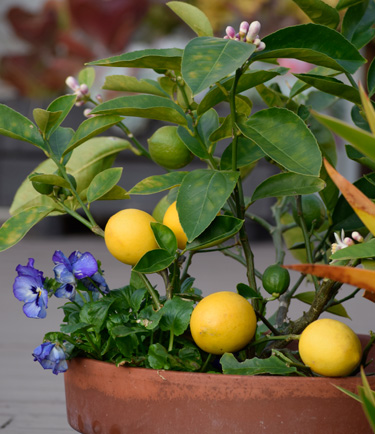
Meyer lemon in pot

Grapefruit

Clementine mandarin
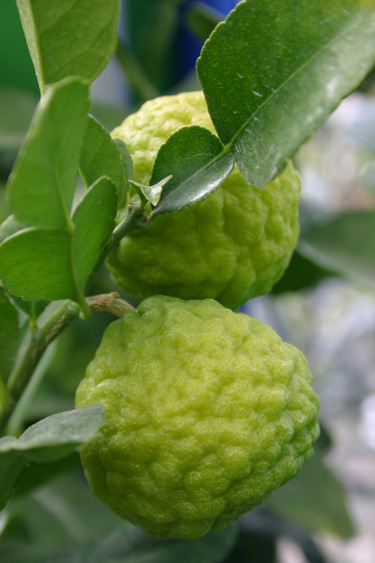
Kaffir lime
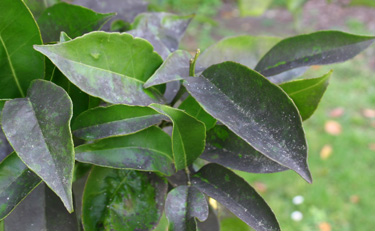
Sooty mould
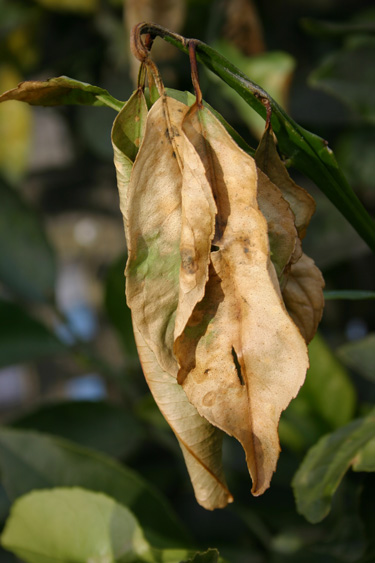
Frost damage
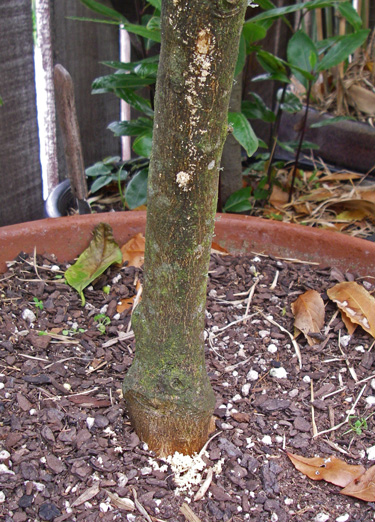
Lemon tree borer


